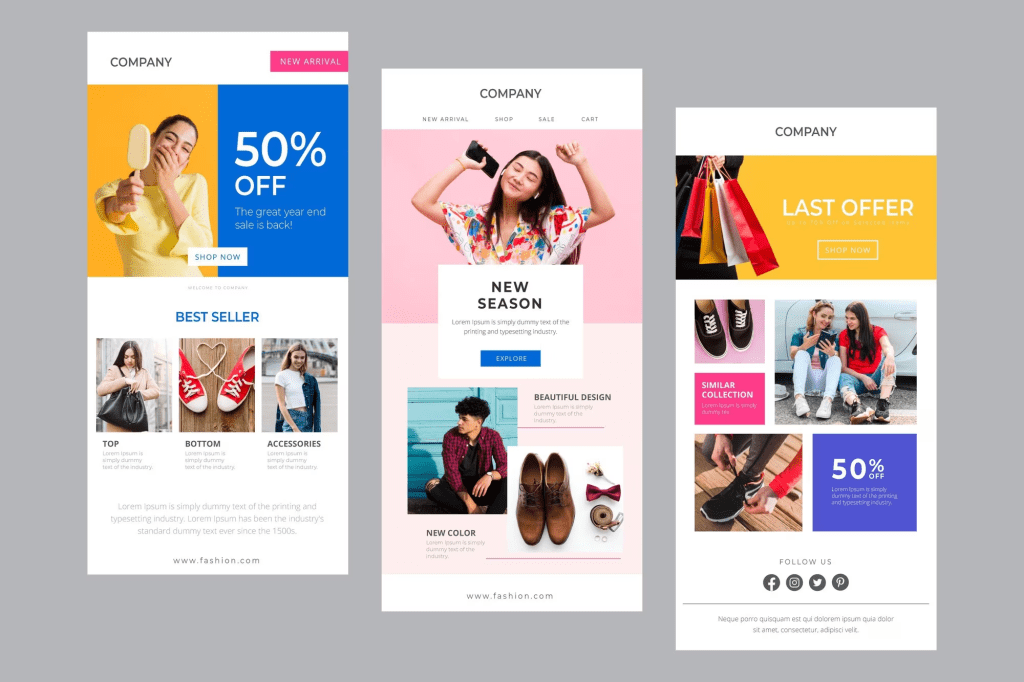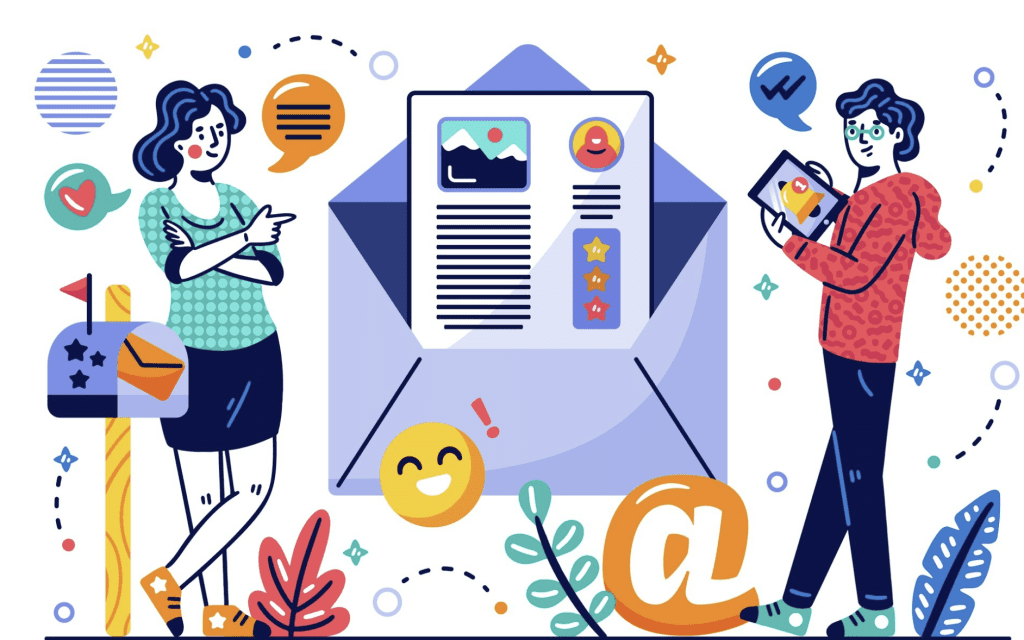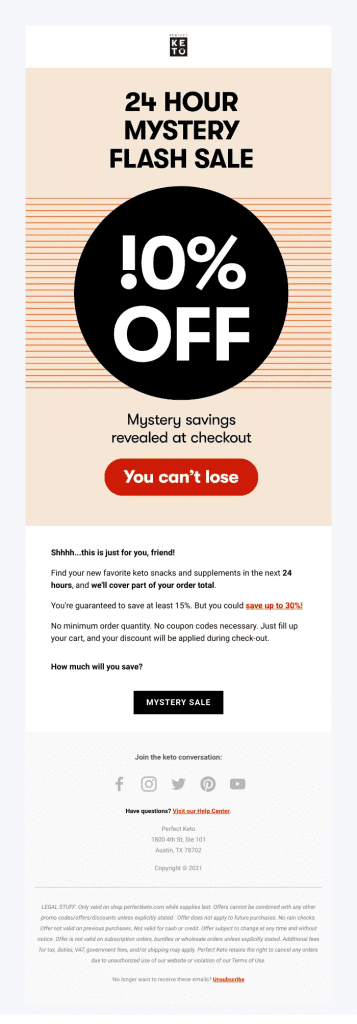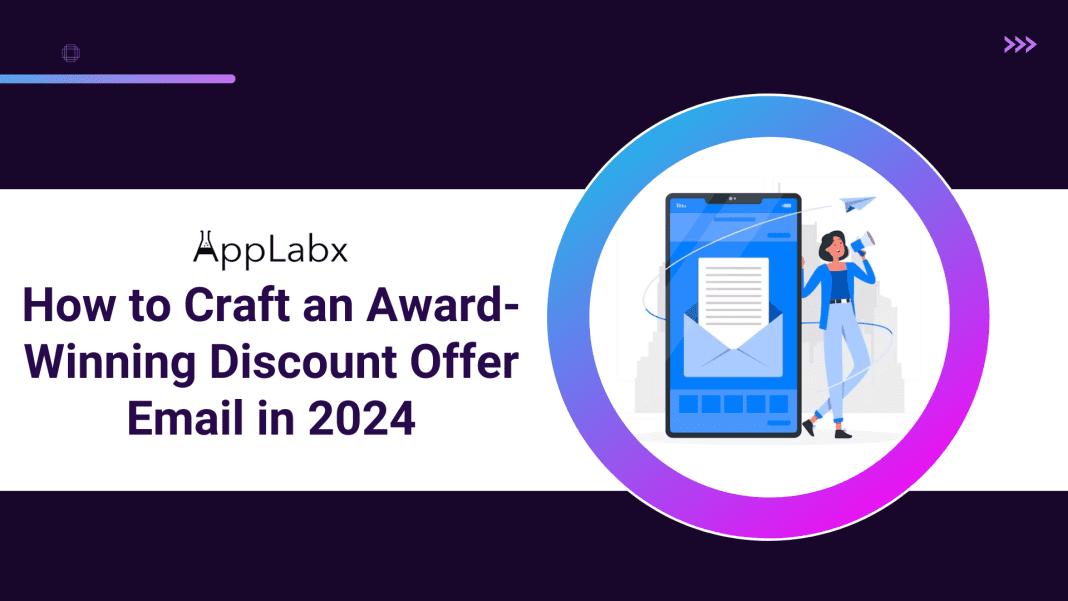Key Takeaways
- Visual Brilliance: Elevate engagement with mobile-friendly design, compelling visuals, and interactive elements to create visually stunning discount offer emails.
- Compelling Copy: Master the art of persuasion, headline crafting, and urgency incorporation for a copy that resonates, compels action, and stands out in the inbox.
- Optimized Conversions: Implement strategic segmentation, leverage social proof, and create mobile-friendly experiences to maximize engagement and drive conversions, ensuring award-worthy email campaigns in 2024.
In the ever-evolving landscape of digital marketing, email remains an undisputed titan, standing the test of time as a potent tool for engaging audiences.
As we step into 2024, the significance of a well-crafted email has only intensified, making it imperative for marketers to hone their skills and adapt to the dynamic preferences of consumers.
In this comprehensive guide, we delve deep into the art and science of crafting discount offer emails that not only grab attention but stand out as award-winning masterpieces.

The Pinnacle of Email Marketing in 2024
In a world where attention spans are fleeting and competition for inbox real estate is fierce, email marketing has emerged as a strategic linchpin for brands.
Unravel the dynamics of the digital landscape in 2024 and understand why email remains an unparalleled channel for connecting with your audience.
Navigating the Landscape of Consumer Behavior
Dive into the nuances of consumer behaviour trends that define the contemporary marketplace.
Learn how to decipher the intricacies of your target audience, identifying their preferences, pain points, and aspirations that will inform your discount offer email strategy.
The Blueprint: Setting Clear Objectives for Success
Crafting an award-winning discount offer email begins with a clear sense of purpose.
Establish measurable objectives that align with broader marketing strategies, ensuring your email campaigns are not just about discounts but strategic moves towards organizational goals.
The Power of Personalization Techniques
Personalization goes beyond addressing your recipient by their first name.
Explore dynamic content strategies, segmentation based on robust customer data, and the art of creating discount offers that resonate personally with diverse segments of your audience.
Aesthetics Matter: Designing a Visually Appealing Email
In the visually-driven landscape of 2024, a compelling design is non-negotiable.
Discover the secrets to creating an email layout that not only captivates but seamlessly adapts to various devices, ensuring your audience experiences visual allure, whether on desktop or mobile.
Crafting Compelling Copy: Words That Convert
The art of persuasion lies in your words. Explore the craft of writing headlines that grab attention, subheadings that guide the reader, and a concise yet persuasive copy that compels action.
Uncover the secrets of linguistic finesse that transform your discount offer into an irresistible proposition.
This is just the beginning of our journey into the realms of crafting an award-winning discount offer email in 2024.
Stay tuned for upcoming sections where we unravel the importance of urgency, delve into the intricacies of conversion optimization, and explore the fascinating realm of testing, analytics, and compliance.
It’s time to elevate your email marketing game and leave an indelible mark on your audience.
But, before we venture further, we like to share who we are and what we do.
About AppLabx
From developing a solid marketing plan to creating compelling content, optimizing for search engines, leveraging social media, and utilizing paid advertising, AppLabx offers a comprehensive suite of digital marketing services designed to drive growth and profitability for your business.
AppLabx is well known for helping companies and startups use email marketing to drive web traffic to their websites and web apps.
At AppLabx, we understand that no two businesses are alike. That’s why we take a personalized approach to every project, working closely with our clients to understand their unique needs and goals, and developing customized strategies to help them achieve success.
If you need a digital consultation, then send in an inquiry here.
How to Craft an Award-Winning Discount Offer Email in 2024
- Understanding Your Audience
- Setting Clear Objectives
- Leveraging Personalization Techniques
- Designing a Visually Appealing Email
- Crafting Compelling Copy
- Creating a Sense of Urgency
1. Understanding Your Audience
In the dynamic realm of email marketing, a profound understanding of your audience is the bedrock for crafting compelling and award-winning discount offer emails.
In 2024, consumers are more discerning and selective than ever before, necessitating a strategic approach rooted in comprehensive audience analysis.

Demographic Deep Dive
Age Groups and Preferences:
Leverage data from sources like the Pew Research Center to understand how different age groups interact with email marketing.
Geographical Variances:
Tailor your discount offers based on regional preferences. Utilize analytics tools to identify areas with high engagement.
Example: A clothing retailer might find that discount offers emphasizing warm weather attire perform better in regions with a predominantly hot climate.
Behavioural Trends Analysis
Purchase History:
Dive into your customer database to identify past purchasing behaviours.
Leverage this information to create targeted and relevant discount offers.
Example: Amazon’s personalized recommendations are a prime illustration, where past purchase data is used to suggest complementary products.

Online Engagement Metrics:
Utilize tools like Google Analytics to track online behaviours, click-through rates, and time spent on different pages.
Example: If your audience predominantly engages with your blog content, incorporating exclusive blog-reader discounts may be particularly effective.

Social Media Integration
Platform Preferences:
Analyze which social media platforms your audience frequents and integrate elements from those platforms into your email campaigns.
Example: If your audience is active on Instagram, consider incorporating visually appealing content similar to Instagram Stories into your emails.
Influencer Affinity:
Identify influencers your audience follows and consider collaborations or influencer partnerships for your discount offers.
Example: Fashion brands collaborating with popular Instagram influencers for exclusive discounts to tap into their follower base.
Technological Proficiency
Device Preferences:
Optimize your email campaigns for the devices your audience predominantly uses.
Responsive design is crucial for a seamless user experience.
Example: 55% of emails are opened on mobile devices, emphasizing the importance of mobile optimization.
Tech-Savvy Segmentation:
Segment your audience based on tech proficiency.
Tailor discounts are offered differently for tech-savvy users compared to those less familiar with technology.
Example: A software company might offer exclusive discounts on advanced features to tech-savvy users while providing user-friendly tutorials for beginners.
Psychographic Insights
Lifestyle and Values:
Understand the values and lifestyles of your audience.
Craft discount offers that align with their aspirations and ethical considerations.
Example: Sustainable brands can create discount offers emphasizing eco-friendly practices to resonate with environmentally conscious consumers.
Brand Affinities:
Analyze the brands your audience engages with.
Tailor your discount offers to align with their existing brand affinities.
Example: A tech brand might collaborate with another brand popular among its audience to offer joint discounts, providing added value.
Also, read our top guide on the Top 7 Best Email Marketing Courses and Certifications to get started on learning Email Marketing.
2. Setting Clear Objectives
In the intricate world of crafting award-winning discount offer emails, setting clear objectives is the North Star guiding your campaign.
In 2024, as email marketing continues to evolve, strategic clarity is paramount for ensuring your efforts align with broader organizational goals and yield tangible results.

Defining Purposeful Discount Objectives
Conversion Goals:
Clearly define the primary goal of your discount offer email.
Whether it’s boosting sales, increasing subscriptions, or driving website traffic, specificity is key.
Example: A clothing retailer might set a goal of achieving a 20% increase in online sales through a targeted discount campaign.

Brand Awareness and Engagement:
Objectives extend beyond immediate conversions.
Consider brand-building and engagement metrics to foster a long-term relationship with your audience.
Example: A startup may prioritize increasing brand awareness by aiming for a 15% growth in social media engagement resulting from the email campaign.
Aligning Email Objectives with Marketing Strategies
Integration with Larger Campaigns:
Ensure your discount offer email aligns seamlessly with ongoing marketing initiatives.
This synergy amplifies the impact of your email campaigns.
Example: If running a seasonal marketing campaign, your email objectives could be tightly integrated to complement the overall theme and messaging.
Omnichannel Coordination:
Leverage data from MarketingSherpa, emphasizing the importance of omnichannel marketing. Coordinated efforts across channels to enhance overall campaign effectiveness.
Example: Integrate your email discount offers with in-store promotions, ensuring a cohesive experience for both online and offline customers.

Measurable and Time-Bound Goals
SMART Criteria:
Apply the SMART (Specific, Measurable, Achievable, Relevant, Time-bound) criteria to your objectives.
This framework enhances clarity and feasibility.
Example: Instead of a vague objective like “increase sales,” set a SMART goal such as “achieve a 10% increase in online sales within the next 30 days.”
Utilizing Benchmark Data:
Refer to industry benchmarks to set realistic goals.
Research from Campaign Monitor or Mailchimp can provide insights into average email open rates, click-through rates, and conversion rates.
Example: Benchmarking against industry averages, set an objective to surpass the average email open rate by 5% in your upcoming discount offer campaign.
Iterative Objectives for Continuous Improvement
Learning from Past Campaigns:
Analyze data from previous email campaigns to inform current objectives.
Identify areas of improvement and build on successful strategies.
Example: If a previous discount offer led to a spike in website traffic but limited conversions, set an objective to optimize the conversion funnel for the upcoming campaign.
A/B Testing for Optimization:
Integrate A/B testing into your objectives. Continuously experiment with different elements, from subject lines to call-to-action buttons, for ongoing optimization.
Example: A travel agency may set an objective to A/B test two variations of discount offers to determine which resonates better with their audience.
3. Leveraging Personalization Techniques
In the digital age, personalization stands as the cornerstone of effective email marketing.
Tailoring your discount offer emails to individual preferences not only captures attention but also fosters a sense of connection with your audience.
In 2024, the bar for personalization has been raised, demanding a strategic approach that goes beyond basic salutations.

Dynamic Content Strategies
Product Recommendations:
Implement personalized product recommendations based on past purchases or browsing history.
Implementing personalized product recommendations can increase conversion rates by up to 300%.
Example: An online bookstore can personalize discount offers by recommending books similar to previous purchases.

Dynamic Offers:
Utilize dynamic content to display different discount values or products based on customer segments.
This approach significantly enhances relevance.
Example: An e-commerce platform may adjust discount percentages based on a customer’s historical spending patterns, offering a higher discount to loyal customers.
Segmentation for Personal Relevance
Behavioural Segmentation:
Segment your audience based on behaviour, such as frequent purchases, cart abandonment, or specific product interests.
Epsilon reports that 80% of consumers are more likely to make a purchase when brands offer personalized experiences.
Example: A fashion retailer can target a segment of customers who frequently browse a specific category with tailored discount offers in that category.
Demographic Personalization:
Tailor your discount emails based on demographic data.
Example: A fitness brand may customize offers for different age groups, promoting age-appropriate products or fitness routines.

Personalized Subject Lines and Greetings
Behavior-Driven Subject Lines:
Craft subject lines that resonate with individual preferences, incorporating data-driven insights.
A study revealed that emails with personalized subject lines are 26% more likely to be opened.
Example: An online electronics store may use a subject line like “Exclusive Tech Deals for [Customer Name]” to grab attention.
Localized Greetings:
Personalize greetings based on the recipient’s location.
HubSpot found that personalized call-to-actions perform 202% better than basic CTAs.
Example: A global brand can tailor discount offers based on local holidays or events, creating a sense of relevance and immediacy.
Utilizing Customer Data for Personal Touch
Social Media Integration:
Leverage social media data to personalize your emails. 57% of consumers are willing to share personal data in exchange for personalized offers or discounts.
Example: Incorporate user-generated content from social media in your emails, showcasing customers using your products.
Past Interaction History:
Reference past interactions in your emails, such as recent purchases, reviews, or webinar attendance.
This not only personalizes the content but also reinforces brand engagement.
Example: An educational platform can send targeted discount offers for advanced courses to users who recently completed beginner-level courses.
4. Designing a Visually Appealing Email
In the highly competitive world of email marketing, the visual appeal of your emails plays a pivotal role in capturing the audience’s attention and driving engagement.
As we venture into 2024, where aesthetic standards are continually evolving, it’s crucial to master the art of designing visually appealing emails.
This guide will explore key principles, strategies, and data-driven insights to help you craft emails that not only stand out in crowded inboxes but also convert recipients into loyal customers.

Mobile-Friendly Design: Catering to the On-the-Go Audience
Mobile Usage Statistics:
Optimize your email designs for mobile devices to ensure a seamless user experience.
Example: Implement responsive design principles, such as single-column layouts and touch-friendly buttons, to enhance mobile readability and interaction.

AMP for Email:
Explore the use of Accelerated Mobile Pages (AMP) for Email to create dynamic and interactive content.
Example: Incorporate interactive carousels or forms directly within the email, providing a more engaging experience for mobile users.
Visual Storytelling: Captivating the Audience with Compelling Imagery
Importance of Visual Content:
Content with good images gets 94% more views than those without.
Leverage visual storytelling to convey your message effectively.
Example: Showcase your product or service through a series of high-quality images, allowing recipients to visualize its benefits.
Branding through Visual Elements:
Consistent visual branding across emails reinforces brand recognition.
A study indicates that consistent brand presentation across all platforms can increase revenue by up to 23%.
Example: Use your brand colours, fonts, and imagery consistently in email designs to strengthen brand identity and build trust.
Eye-Catching Graphics and Icons: Enhancing Visual Appeal
Use of Infographics:
Infographics are powerful tools for conveying information. Infographics are liked and shared on social media 3X more than any other type of content.
Example: Create an infographic summarizing key information about your discount offer, making it visually appealing and shareable.
Incorporating Icons:
Icons provide visual cues and break up text, enhancing the overall visual appeal.
Example: Use icons to represent different product categories or features, making the email more visually engaging and scannable.
Interactive Elements: Engaging the Audience Beyond Static Content
Interactive Images and Carousels:
Incorporate interactive elements like image carousels to engage recipients. Interactive email content increases the click-to-open rate by up to 73%.
Example: Create a carousel showcasing multiple product images, allowing users to interact and explore different offerings directly within the email.

Embedded Videos:
Video content can be embedded directly into emails, offering a dynamic experience.
Including video in an email leads to a whopping 200-300% increase in click-through rate.
Example: Include a brief video demonstrating the benefits of your discount offer or providing a behind-the-scenes look at your brand.
Typography: Striking a Balance Between Readability and Aesthetics
Font Choices:
Choose fonts that align with your brand and enhance readability.
A good rule is to use no more than three fonts.
Example: Select a primary font for body text, a complementary font for headings, and a distinctive font for CTAs, maintaining a cohesive and visually appealing look.
Hierarchy and Emphasis:
Establish a clear hierarchy with font sizes and styles to guide the reader.
Example: Use larger fonts for headlines and bold styles for important information, ensuring key details stand out and are easily digestible.
Colour Psychology: Eliciting Emotions and Conveying Brand Identity
Understanding Color Meanings:
Different colours evoke distinct emotions. For instance, blue is associated with trust and calmness, while red signifies urgency and passion. Consider colour psychology when designing your emails.
Example: If your discount offer emphasizes urgency, incorporate red elements to convey a sense of immediacy and importance.
Consistent Color Scheme:
Maintain a consistent colour scheme throughout your email. A study revealed that people make a subconscious judgment about a person, environment, or product within 90 seconds of initial viewing and that between 62% and 90% of that assessment is based on colour alone.
Example: Align your email colour scheme with your brand colours, reinforcing brand identity and creating a visually cohesive experience.
Whitespace: Embracing Simplicity for Enhanced Readability
Whitespace as a Design Element:
Strategic use of whitespace improves readability and enhances the overall aesthetic appeal.
According to a study, sites that use whitespace judiciously can increase comprehension rates by up to 25%.
Example: Ensure that there’s ample space around key elements in your email, preventing visual clutter and allowing recipients to focus on the core content.
Balancing Visual Elements:
Strike a balance between visual elements and whitespace.
Example: Avoid overcrowding your email with too many images or text.
Use whitespace to guide the reader’s eyes and create a visually pleasing layout.
Responsive Design: Ensuring Consistency Across Devices
Importance of Responsive Design:
With diverse devices used for email consumption, responsive design is crucial. Litmus reports that 80% of people delete an email if it doesn’t look good on their mobile device.
Example: Test your email design across various devices and email clients to ensure a consistent and visually appealing experience for all users.
Fluid Layouts and Scalable Images:
Create fluid layouts and use scalable images to adapt to different screen sizes.
This ensures that your email maintains its visual appeal regardless of the device.
Example: Design images with flexibility in mind, allowing them to resize seamlessly without losing quality on smaller screens.
5. Crafting Compelling Copy
In the realm of email marketing, the effectiveness of your message often hinges on the power of your copy.
Crafting compelling copy is an art that combines persuasion, clarity, and relevance.
As we navigate through the intricacies of email campaigns in 2024, let’s delve into the strategies and principles that will elevate your copywriting, driving engagement and conversions.

Understanding the Psychology of Persuasion
Principles of Persuasion:
Leverage Robert Cialdini’s six principles of persuasion – reciprocity, commitment, social proof, authority, liking, and scarcity.
These principles can influence consumer behaviour positively.
Example: Introduce scarcity by emphasizing limited-time offers, prompting users to act swiftly to secure exclusive discounts.
Power Words and Emotional Appeal:
Use powerful words that evoke emotions and resonate with your audience.
Words like “free,” “new,” and “you” tend to perform well in email subject lines.
Example: Craft a subject line like “Unlock Your Exclusive Offer – Limited Time Only” to trigger a sense of exclusivity and urgency.
Headlines that Command Attention
Importance of Headlines:
Eight out of 10 people will read the headline, but only two will read the rest.
Craft headlines that captivate and compel further reading.
Example: For a discount offer, a headline like “Unwrap Savings: Your Exclusive [Product] Deal Inside.” entices recipients to explore the offer.
Clarity and Curiosity:
Balance clarity with curiosity in your headlines.
Example: A headline such as “Discover Your Mystery Discount: Unveil the Savings Inside.” combines clarity about a discount offer with a hint of curiosity.
Persuasive Language in the Body Copy
Customer-Centric Approach:
Centre your copy around the customer’s needs and benefits.
Example: Instead of generic statements, say “Unlock 20% Off Your Next Purchase” to directly address the value for the customer.
Feature vs. Benefit Emphasis:
Emphasize the benefits of your product or service rather than just listing features.
Example: Instead of saying “High-Quality Material,” say “Experience Unmatched Comfort with Our Premium Fabric.”
Optimizing Call-to-Action (CTA) Buttons
Clear and Actionable Text:
Craft clear and actionable CTA buttons.
Example: Instead of a generic “Shop Now,” personalize the CTA with “Claim Your Discount” for a more targeted approach.
Contrasting Colors:
Make your CTA button stand out with contrasting colours.
Example: Use a bold colour for the CTA button that contrasts with the email’s background, ensuring it catches the recipient’s attention.

A/B Testing for Copy Optimization
Importance of A/B Testing:
Conduct A/B tests on different elements of your copy, from subject lines to body text.
Example: Test variations of your discount offer copy, experimenting with different wording or emphasis on specific benefits.
Iterative Improvements:
Use A/B test results to iteratively improve your copy. Analyze data on open rates, click-through rates, and conversions to refine your messaging.
Example: If a certain style of language resonates better, incorporate it into future campaigns to continuously optimize your approach.
Tailoring Copy to Audience Segmentation
Segmentation for Personalization:
Segment your audience based on demographics, behaviours, or preferences.
Targeted emails generate 58% of all revenue for marketers.
Example: Tailor copy for different segments; a tech-savvy segment may respond better to technical details, while a casual segment may appreciate a more conversational tone.
Personalized Recommendations:
Include personalized product recommendations in your copy.
Example: Recommend specific products based on a customer’s past purchases, increasing the relevance and appeal of your discount offer.
Storytelling for Emotional Connection
The Power of Storytelling:
Incorporate storytelling elements to create an emotional connection.
Example: Share a customer success story related to your discount offer, emphasizing how it positively impacted their experience.
Brand Narrative Consistency:
Ensure that your copy aligns with your brand narrative.
Example: If your brand is known for humour, infuse your copy with witty elements that resonate with your established brand voice.
Incorporating Social Proof
Impact of Social Proof:
Integrate social proof in your copy to build trust.
Example: Include customer testimonials or highlight the number of satisfied customers who have already benefited from similar discount offers.
User-Generated Content (UGC):
Feature UGC in your copy to showcase real-world experiences.
79% of people say UGC highly impacts their purchasing decisions.
Example: Include images or testimonials from customers who shared their experiences with your products and discounts on social media.
Data-Driven Iterations for Continuous Improvement
Analytics for Insightful Feedback:
Analyze key metrics such as open rates, click-through rates, and conversion rates.
Iterate and optimize your email strategy based on data-driven insights.
Example: If certain types of copy consistently lead to higher conversion rates, use that insight to refine your messaging in future campaigns.
Iterative Adjustments:
Continuously make adjustments based on performance data.
77% of email marketing ROI came from segmented, targeted, and triggered campaigns.
Example: If a particular discount offer resonates well with a specific segment, consider tailoring future offers to cater more specifically to that audience.
6. Creating a Sense of Urgency
In the fast-paced world of email marketing, one of the most potent tools at your disposal is the ability to instil a sense of urgency.
By strategically crafting messages that evoke a feeling of immediacy, you can drive recipients to take prompt action.
In this comprehensive guide, we explore the psychology behind creating urgency, the various techniques at your disposal, and real-world examples that showcase the effectiveness of urgency in email campaigns.

Understanding the Psychology of Urgency
Fear of Missing Out (FOMO):
Tap into the psychological principle of FOMO, where individuals fear missing out on something valuable.
A study found that 69% of millennials experience FOMO.
Example: Craft a subject line like “Last Chance. Exclusive Offer Ends Tonight,” triggering FOMO and compelling recipients to seize the opportunity.
Scarcity and Abundance:
Leverage the scarcity principle, emphasizing limited availability or quantity.
Example: Highlight limited stock with phrases such as “Only 10 Left” or “Limited Stock – Act Fast,” emphasizing scarcity and prompting quicker decisions.
Strategic Use of Countdowns and Timers
Countdown Timers in Emails:
Embed countdown timers in your emails to visually represent the ticking clock.
Example: Use a countdown timer for flash sales, limited-time discounts, or exclusive offers, showcasing the remaining time for users to avail themselves of the deal.

Dynamic Element for Visual Appeal:
A countdown timer adds a dynamic element to your email, capturing attention and creating a sense of urgency.
Example: Implement a countdown timer prominently in the email header to instantly convey the limited time remaining for the special offer.
Limited-time offers and Flash Sales
Clear Expiry Dates:
Clearly communicate the expiration date of your offer.
Example: State “Offer Valid Until [Date]” or “24-Hour Flash Sale” to provide clarity on when the promotion concludes.

Flash Sale Phrases:
Incorporate phrases associated with urgency for flash sales.
Example: Craft a call-to-action like “Shop Now – Flash Sale Ends in 12 Hours,” conveying both urgency and the exclusive nature of the offer.
Dynamic Pricing Strategies
Progressive Discounting:
Implement a progressive discount structure where the discount decreases over time.
Dynamic pricing enables companies to optimize their pricing strategies.
Example: Start with a higher discount early in the promotion, gradually reducing it as the deadline approaches, encouraging early action.
Limited-Time Price Drops:
Introduce temporary price drops for a specified duration.
Example: Advertise a reduced price for a product, explicitly stating that the discounted rate is only applicable until a certain date.
Incorporating Urgency in Subject Lines
Action-Oriented Language:
Use action-oriented language in subject lines to prompt immediate attention.
Example: Employ phrases like “Don’t Miss Out,” “Act Now,” or “Limited Time Offer” to convey urgency and encourage recipients to open the email promptly.
Emojis for Emphasis:
Integrate emojis strategically in subject lines to enhance urgency.
Emails with emojis in the subject line had a 56% higher open rate.
Example: Combine a clock emoji with a time-sensitive message, such as “⏰ Final Hours – Exclusive Deal Inside.”
Segmentation for Targeted Urgency
Behaviour-Based Segmentation:
Segment your audience based on their behaviour and engagement history.
Example: Send urgency-focused emails to segments that have previously responded positively to time-limited offers, tailoring the urgency level based on past engagement.
Personalized Urgency Levels:
Personalize urgency levels based on user preferences and purchase history.
Example: Adjust urgency messaging for different segments; for frequent shoppers, emphasize early access to sales, while lapsed customers may receive stronger urgency cues.
Feedback Loops and Iterative Improvements
Analytics for Urgency Performance:
Analyze key metrics related to urgency campaigns, including open rates, click-through rates, and conversion rates.
Use this data to assess the effectiveness of urgency in driving desired actions.
Example: If a countdown timer consistently leads to higher conversions, consider incorporating it into future time-sensitive campaigns.
Iterative Adjustments Based on Data:
Make iterative adjustments to your urgency strategies based on performance data.
Example: If certain urgency phrases resonate better with specific segments, incorporate those learnings into your overall email strategy.
Legal and Ethical Considerations
Transparency in Communication:
Ensure transparency in your urgency messaging.
Clearly communicate terms and conditions, avoiding misleading statements. Trust is crucial for long-term customer relationships.
Example: Clearly state limitations such as “Limited stock, while supplies last” to provide transparency and maintain trust.
Compliance with Regulations:
Adhere to email marketing regulations, including guidelines on urgency and promotional messaging.
Non-compliance can lead to penalties and damage brand reputation.
Example: Ensure that your urgency messaging aligns with regulations such as CAN-SPAM and GDPR, respecting user preferences and privacy.
Conclusion
As we traverse the dynamic landscape of digital marketing in 2024, the art of crafting an award-winning discount offer email stands as a pinnacle of email marketing excellence.
In this comprehensive guide, we’ve navigated through the intricacies of email design, the nuances of compelling copywriting, and the strategic deployment of urgency to create emails that not only captivate but also convert.
Elevating Visual Appeal for Impactful Engagement
In the realm of email design, we explored the importance of mobile responsiveness, the significance of visual storytelling, and the integration of interactive elements.
By embracing mobile-friendly practices, utilizing compelling visuals, and incorporating interactive features, you can ensure that your discount offer emails not only catch the eye but also deliver a memorable and engaging experience.
Crafting Compelling Copy: The Art of Words that Drive Action
Delving into the art of copywriting, we uncovered the psychology of persuasion, the power of headlines, and the techniques for creating a sense of urgency.
By leveraging persuasion principles, crafting attention-grabbing headlines, and infusing urgency into your copy, you can create messages that resonate with your audience and drive them to take immediate and meaningful actions.
Designing a Visually Appealing Email
Understanding that visual appeal is a crucial facet of email marketing, we explored the elements of a visually appealing email, such as responsive design, fluid layouts, and scalable images.
By implementing these design principles, you can ensure that your emails not only look good on various devices but also provide a seamless and visually pleasing experience for every recipient.
Crafting Compelling Copy: The Art of Words that Drive Action
In the realm of copywriting, we explored the psychology of persuasion, the importance of headlines, and the strategies for creating a sense of urgency.
By applying principles of persuasion, crafting captivating headlines, and instilling urgency into your copy, you can create messages that resonate with your audience and drive them to take swift and meaningful actions.
Creating a Sense of Urgency: A Tactical Guide to Drive Immediate Action
Understanding the psychological triggers behind urgency, we explored tactics such as fear of missing out (FOMO), strategic use of countdowns, and the impact of limited-time offers.
By incorporating these elements, you can create a sense of urgency that compels recipients to act swiftly, enhancing the effectiveness of your discount offer emails.
If you are looking for a top-class digital marketer, then book a free consultation slot here.
If you find this article useful, why not share it with your friends and business partners, and also leave a nice comment below?
We, at the AppLabx Research Team, strive to bring the latest and most meaningful data, guides, and statistics to your doorstep.
To get access to top-quality guides, click over to the AppLabx Blog.
People also ask
How do you write a discount offer email?
Crafting a compelling discount offer email involves a clear subject line, concise details of the promotion, a visually appealing layout, and a strong CTA. Create urgency, highlight benefits, and personalize for maximum impact. Keep it concise, engaging, and mobile-friendly to drive conversions.
How do you write an exciting email announcement?
Big News Unveiled. Brace yourself for something extraordinary. We’re thrilled to share an exciting announcement that will reshape your experience with us. Get ready for innovation, exclusive offers, and more. Stay tuned for the grand reveal.
How do you ask for a discount professionally email?
Dear [Recipient],
I hope this email finds you well. I’ve been considering [product/service], and I was wondering if there’s any possibility of a discount or promotional offer available. I truly value your product/service and believe this would greatly benefit both parties.
Thank you, [Your Name]




































